Chapter 23
Electrifying Induction
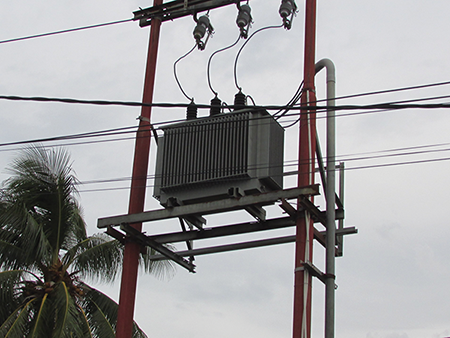
Deliver a small shock with a common transformer.
Before we dive in to tinker, let’s consider safety first. Electricity is invisible, like air, and quite a bit more dangerous. To live long into your golden years, you’d do well not to touch any random wires or electrical boxes, or anything electrical at all that’s wet. Many houses here in Timor use small electrical pumps to draw water from shallow wells, and the combination of low-quality electrical connections, leaky water works, and no safety code has resulted in a heartbreaking number of deaths. So here is your warning:
Now that we know enough to stay alive and healthy, let’s admit that danger is exciting. Who’s not been thrilled by an electrostatic spark emanating from one’s finger after scooting around the carpet in socks? My student in California came back from a visit to Mexico reporting a man in a local tourist park offering to shock people for a small fee. That this guy was making a living is a testament to the excitement of electricity flowing through human tissue.
Actually, current can be flowing through your skin without you even feeling it. Clamp a double-A battery between your thumb and finger and a small current will flow.

Feel anything? I didn’t think so. We need to crank it up a bit to feel alive! That’s where the transformer comes in. You’ve probably seen big ones perched on electrical poles and maybe seen small ones inside home appliances. Both of these applications are transforming a large voltage to a small one—“stepping down the voltage,” in the technical lingo. Here we’ll use a transformer in the other direction, stepping up the 1.5 volts of a common battery to a level that may make you yelp.
Gather stuff
- Battery
- Transformer (Any one will do, and big ones are no better or worse than small ones.)
- Four wires
- Tape
- Partner, if possible
Gather tools
- Wire strippers or knife
- Soldering iron, if you have one
- Multimeter, if you have one
Tinker
First you have to figure out your transformer. It will look something like this:
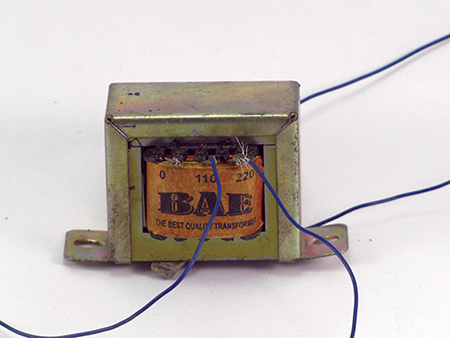
You’ll find it has two sides, each one with at least two connection spots. Here is a diagram of what it looks like inside:

See that the two sides are not connected? They’re complete wire coils with two connection points each. If your transformer has more than two connection points on one or both sides, its schematic diagram looks something like this:
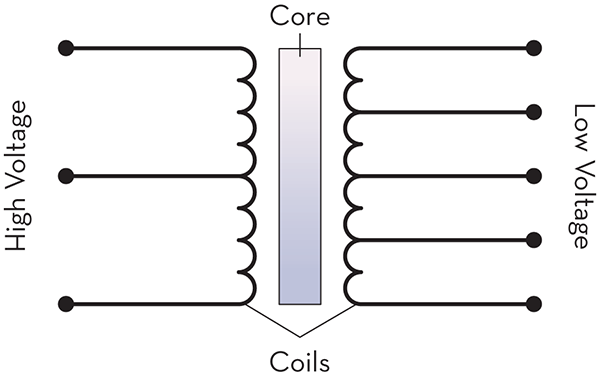
The coils are now represented by the bumpy lines and the core by the thin rectangle in the center. And in this schematic you can’t tell by looking which side has more coils, but the voltage change depends on the number of coils.
Your transformer may be marked with numbers, maybe 220, 110, and 0 on one side and CT, 6, 9, 12, 18, and 24 on the other. CT stands for center, meaning the center of the coil, the middle branches on the schematic above. These numbers are a bit misleading, because what you get out depends on what you put in. So if you hook up 220 volts across the 220 and 0 points on one side, you’ll get those other voltages on the other side, but if you don’t you won’t. We don’t want anywhere near 220 volts, and we’re only going to put in 1.5 volts, so the numbers written on the transformer don’t describe what we’ll see.
The main point is that the voltage is transformed from high to low or low to high, depending on how you hook it up. As I mentioned, normal small transformers like these are commonly connected to the wall outlet voltage and used to drop that voltage to a lower one. We’ll hook ours up the other way to raise the voltage.
Find any two of the connections labeled with lower voltage, maybe 6 and 0 (or CT) and attach two wires. Solder them on if you want. Then connect two wires onto the other side, maybe at 220 and 110. You should now have four wires attached. The exact places are not so important; two wires on each side should do it.
Now you’re ready to go. You can have your partner do this, but you can do it yourself as well. Use your finger and thumb to connect the two wires on the high voltage side. You can’t just touch one; you’ve got to complete the circuit.
When that’s complete, hook up the battery across the two wires on the low voltage side.
Is your heart yet aflutter?

In this arrangement you’ve got one hand touching the higher voltage wires with two fingers. Thus, the electrical current is flowing down one finger, across the hand, and up the other finger.
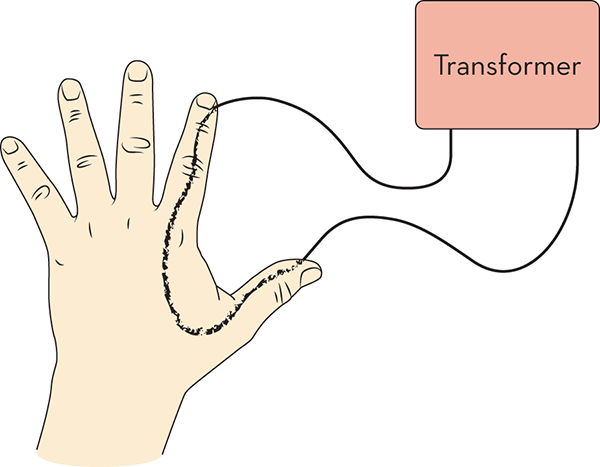
Another way to connect is by grabbing one wire with each hand. For this one you’ll need a partner or clever switching mechanism to hook up the battery. The current now has to run all the way down one arm, across your chest, and up the other arm.


You may notice that your heart, not the least important organ of the body, is right in line with that circuit. More on that later.
You can also hold hands with someone else, or many other people, making a long, happy chain of fools—I mean scientists—all waiting to experience the thrill of electricity. (I’ve done this with more than 30 kids in a chain, some as young as 7, and got only giggles and joy.)

One final experiment to reference when I explain things in a moment: have your partner hook the battery up securely on one side and grab the two wires on the other side.
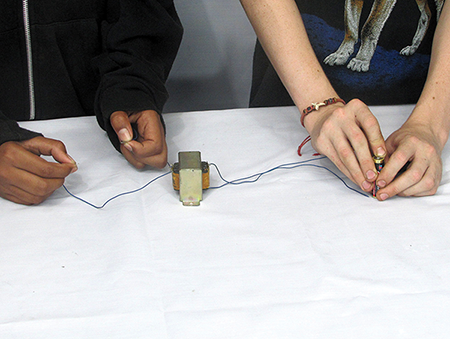
You will feel nothing; so far, so good. Now have your partner disconnect the battery.
Ouch. You’ll get the same shock you did when the battery was connected. Now there’s a stumper.
What’s Going On?
The phenomenon at work here is electromagnetic induction. Any questions? No, but really, that $100 word stands at the culmination of electricity and magnetism. I introduced this section on electricity and magnetism with the transformer shock because it’s so cool and memorable, and not at all because it’s an easy place to begin explaining. The other activities in this chapter will explain a bit more about electrical circuits and magnetism.
Here we’ve fed a battery-powered current into a coil, which becomes an electromagnet. There is a second coil inside that transformer seated just beside the one getting the battery’s current. When the first coil’s magnetic field builds up, it causes a current to flow in the second coil; that’s called induction, because it’s an induced current. It requires both electricity and magnetism; thus it’s electromagnetic induction. (Both electrical induction and magnetic induction also exist; feel free to have a go at finding out what those two are all about.)
It’s critical to note two things about the transformer. First, the two coils are not electrically connected. You can prove this with a multimeter or by taking apart the transformer. Second, the coils are not the same size. If you take apart the transformer, you’ll find the coil on the side labeled with the high voltages has more coils.
Now the key to it all: induction happens only when the magnetic field of the first coil is either building up or collapsing. That happens when the current is increasing or decreasing—that is, just as you connect it or just when you disconnect it. If the magnetic field is standing strong and steady—the circuit is complete and the current is flowing strong and steady—you get no induced current at all.
It’s a bit mystical, eh? That’s what the first scientists to note this effect must have thought.
There he was, Hans Christian Ørsted, a teacher doing a science demonstration lecture in 1820 Denmark with a table full of marvelous equipment, both electric and magnetic. Right in the middle of it all, he noticed a magnetic compass twitch when he completed a nearby circuit.
This is nothing to sneeze at. That finding—the linking of electricity and magnetism—was arguably the most significant discovery in modern physics and engineering. Within a year, Michael Faraday had constructed a working electrical motor using this concept, and to date the hours of mindless manual labor saved by electric motors must surely number in the gazillions.
That was mystical enough; an electrical current could create a force the same way chunk of magnetic iron can. But that wasn’t yet the concept here! It was ten more years before Faraday discovered electromagnetic induction—the stunning fact that one current can set up a magnetic field that in turn induces another current. This paved the way for transformers and voltage control. Check out this photo of Faraday’s transformer here: way high tech, 1840.1
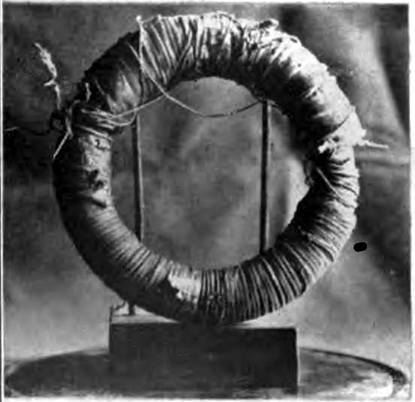
CREDIT: Wikipedia Commons
Today, transformers are used all over the place to transform voltages. At power plants voltage is bumped up into the hundreds of thousands, which makes power transmission more efficient. It’s also more deadly, so high towers keep the wires far out of reach. Before the electricity comes back down and into your house, it goes through another transformer that steps the voltage back down to around 120V in North America, or 240V in most of the world. This much voltage often does not result in death upon touching, especially if you’re not wet. It also helps if you touch it with only one hand, and if you’re wearing shoes.
Another safety tidbit: When professional electricians are looking into a problem or exploring a snarl of wires from unknown sources, you’ll often see them with one hand behind their back. (Don’t try this! Call one of them!) With this one precaution they can prevent electricity traveling right through their heart, as it does in our activity when you grab the two wires with your two hands. Instead, if they happen to touch some rogue electricity, it will attempt to travel through their entire body to the earth, which is a giant neutral sink for electrons. That’s where the shoes come in; rubber soles increase the resistance and thus reduce the current. You may also notice the professionals stand on a wooden or plastic chair to further reduce any unforeseen current.
So fridges and ovens and toasters all use 120V in the United States, but things like computers and clocks and stereos don’t need that much. These things generally have a transformer inside them, which takes the 120 volts down to 12 or 6 volts or just what the thing needs.
Getting back to our phenomena, we have one final concept to learn: DC and AC current. DC means direct current, and it’s what our batteries give. Electrons come out of one side, flow directly through the circuit, and enter the other side. AC means alternating current, and this is what your wall sockets provide to your lights, fridge, and desktop computer. Alternating current is always going back and forth, changing from positive to negative voltage. A transformer will continuously pass this energy from one coil to the other, as the magnetic fields rise and fall continuously.
Transformers are almost exclusively used with alternating current. In this activity we’re hacking the transformer—in essence, giving the current a single alternation (from off to on, or from on to off), and so you only ever get a single jolt. (Unless of course you have an evil mind and a jittery hand, and tappity-tap the wire on the tip of the battery—this will give your trusting partner multiple jolts, thus destroying the friendship for years to come.)
How much voltage are we generating here? I checked this on my oscilloscope, a handy device that plots an electrical signal on a graph of voltage versus time. I got around 40 volts maximum at the spike and about 50 milliseconds for the duration of the current. Many people with dry hands I’ve tested over the years (including myself) have a resistance of around 200,000 ohms, so with a useful equation called Ohm’s law, Current = Voltage/Resistance, you find that the current is 0.2 milliamps. Danger comes only near 100 milliamps through the heart. This is a safe activity.
By the way, there is strength in numbers here. If you join a group of wild adventurers to make a ring holding hands, then the resistance of your circuit is more, so the current will be less for a given voltage. So enjoy safely shocking yourself and your friends. As Sia sang (screamed) over and over in her megahit, nearing a billion hits on YouTube as I write: I Love Cheap Thrills!
